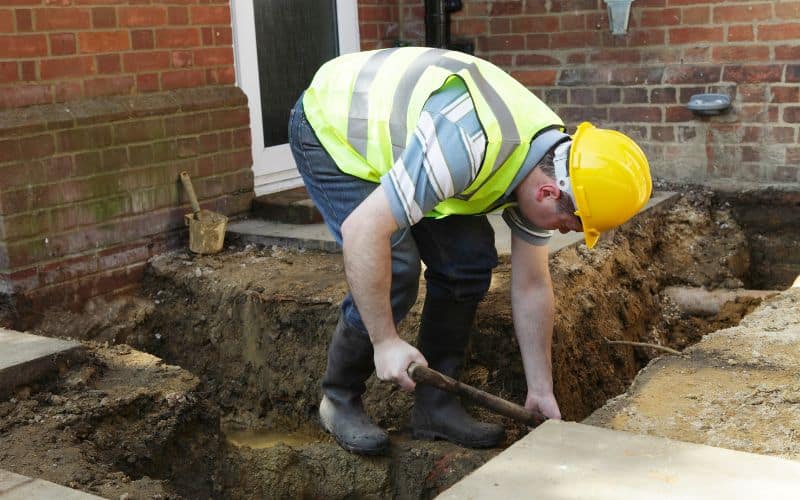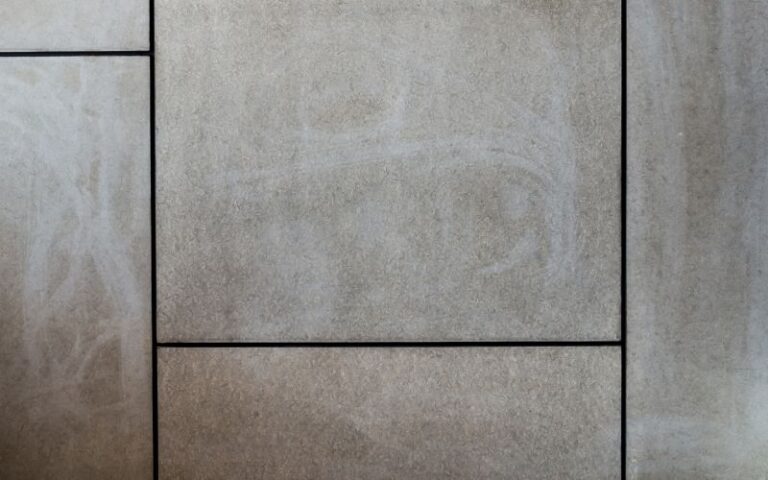You can do most of your digging using heavy machinery or hire a team of experts.
But if you’re working on a budget, you may have to do it yourself and save the money you would have paid the team.
While it is not easy to do heavy manual labor with your hands, it is possible because there are tools you can use to achieve this, albeit for how long.
Hand-digging a foundation can be tedious and risky, but if you plan to save money and use it for other things, you have no better option. Furthermore, it will take longer for you to dig a trench by hand than using heavy machines because the tools available are smaller and can only achieve so much in a short while.
Ready for a Flooring Quiz?
How Do You Dig a Foundation By Hand?

Regarding construction, there are some factors to consider before excavation or digging.
These factors directly affect your project; if you ignore them, there may be heavy consequences or setbacks.
#1. Factors to Consider Before Digging a Foundation
#1. Soil Structure
The soil structure of your construction site has a massive role in your construction. It can influence your foundation’s depth, size, durability, and rigidity and prolong your project.
Before commencing with your digging, have a soil expert test the type of soil in that area and what reinforcement you require.
Then, you can hire a civil engineer to help you understand your soil structure and recommend the appropriate reinforcement and materials you will need.
Some soil types require you to dig deep and build pillars, while others do not need any pillars or extra reinforcement.
Also, the soil structure can determine the depth of your foundation, but you can only know this if you understand your soil structure.
#2. Depth of the Foundation
The depth of your foundation will determine the type of tools you need and how long it will take to complete the project.
If digging through dry and Rocky soil, you may need more than a shovel to break the rocks. You have to evaluate all these before hiring or purchasing any tools.
#3. Regulatory Bodies
If you recently bought the land you’re working on; you will have to first register your interest with the regulatory bodies in that area in order not to go against any rules.
In many states, heavy fines are attached to offenses against the state. Therefore, it is better to avoid issues with the state as a new immigrant.
In addition, not just for new areas alone, but in many countries, you have to get a permit to carry out any new construction, and failure to do so can lead you to trouble.
#2. Preparation
After ticking all the boxes on what to expect, the next step is to prepare your site. You must cut them down and dig out their roots if they contain tees.
This entire process of digging up trees can be exhausting and time-wasting, so it is better to always go to areas with little to no vegetation.
However, if you’ve already bought the land, set a time for uprooting trees and clearing the land.
#3. Requirements
- Safety gears; gloves, glasses, overalls, and boots
- Hammer, Nails, spirit level
- Shovels
- Wheelbarrow
- Strings
- 1×4 lumber for the batter boards
- Hand Saw
Step 1: Map out Your Foundation
Using a hammer and nails, create two batter birds for each outer corner of your foundation.
Each batter board will hold the strings you will use to map the foundation. You can use either 1×4 or 2×4 lumber to make rigid batter boards.
The better you pound the batter boards into the soil, the more balanced the strings will be and the easier it will be for you to dig.
Step 2: Laying the Foundation
You need to pay a lot of attention when laying your foundation because of a slight deviation from the construction permit, and you may have to start over.
When laying the foundation, ensure that the perimeters are proper and correspond with the perimeters on your permit.
Many builders use a simple trick when checking their perimeters; the 3-4-5 method. This method requires you to mark out two points on your string and measure out the diagonal.
If it gives you 5, it means that your measurements are correct and your batter boards and strings are balanced.
First, measure 3′ on one side of the string and Mark it, measure 4′ on the other side and Mark it as well.
Then measure the distance between the marked points; if you get 5′, then the mapping is correct. Repeat this method on all the corners of your foundation before laying the foundation.
Step 3: Begin Digging
After laying your foundation, you can begin digging with the available tools. A hydraulic digger works faster than a shovel. However, you can only use a hydraulic digger on some sites.
For example, if your foundation is close to an existing structure, you can’t use a hydraulic digger because it can affect the foundation of that structure.
Also, renting one can be expensive, so shovels are better. You can hire a team of three to four people to dig with shovels and hope to achieve it in the shortest time possible.
While you can’t be sure of when the project will be complete, working with a shovel gives you more precise work, and you have room to make corrections.
How Long Does It Take Hand-Dig a Foundation?
Your work duration can last between 4-5 days or even 3 weeks depending on several factors like;
#1. The Type of Tools Tour Using
Using a hydraulic digger, you will dig faster and finish sooner than someone using a shovel.
#2. The Number of People in Your Team
A 5-man team will achieve more in a shorter time than a 2-man team. That is why it is advisable to have enough people digging, even if you can’t afford to hire experts or use a hydraulic digger.
#3. Your Soil Structure
The type of soil you’re working on can influence your entire project down to how long it will take to finish it.
For example, if you’re digging on rocky soil, it will take you days to dig up to the depth you want.
#4. Depth of the Foundation
The depth and size of your foundation can also prolong or shorten your work. The deeper and wider the foundation, the more time it will take you to dig.
Overall, there’s no standard time to Hand-Dig a foundation because there are a lot of factors that affect it.
However, with efficient tools and agile team members, you should be able to finish digging in a matter of a week or two, depending on the size.
How Do You Measure the Depth of Your Foundation?
You can measure the depth of your foundation using Rankin’s formula, but you have to consider certain factors.
- The soil-bearing capacity
- Depth of water level below the ground level
- Estimated load
- Soil-type depth of layers
Rankin’s formula uses three significant parameters to determine the minimum depth of the foundation.
Using the density of the soil, gross bearing capacity, and internal friction in the soil, you can use Rankin’s formula for calculating the foundation.
- First, measure the soil bearing capacity, the density of the soil, and the internal friction. You can take a sample of the soil to a soil lab to test it.
- Assign someone letters to represent the parameters. You can use the standard letters in the formula or any of your choice.
- Given that Rankin’s formula is h=p/y{1-sinø/1+sinø}².
h= minimum depth of the foundation
p= gross bearing capacity
y= density of soil
Ø = internal friction
There are other ways of measuring the depth of your foundation. However, this is the most straightforward way.
Although it doesn’t consider the factors that can affect the depth of your foundation, it gives a direct formula for calculating the depth.
Is It Hard to Hand-Dig a Foundation?
Hand-digging a foundation can be challenging and risky, depending on your tools and the type of soil you’re working on. But even with the best tools, it is a challenging task.
From clearing the land to digging and packing the sand, you will be doing a lot of manual labor that will require you to keep moving.
You may sustain injuries if you’re not with the right protective gear or tools.
The least you can do when hand-digging is to get all the tools available because you’ll need them to achieve the same work a machine would.
You can make things easier by ensuring you have all the necessary tools, protection gears, and an agile team.
The people you work with can also slow down the work if they do little. Hiring professionals is always the best, but if you cannot, try to hire an agile team.
How Do You Dig Foundation Footings?
Footings are part of the primary support systems of a structure. They provide extra reinforcement to both the foundation and the structure and bear the load of the superstructure.
People not into building and construction always mistake Foundation and Foundation Footings because of how similar their description is; however, there are differences.
#1. Differences Between Foundation and Foundation Footings
| Foundation | Footings |
|---|---|
| It transfers the load from the structures to the earth. | The footings are the lowest part of the building. |
| The foundation mainly supports the columns on the building. | It transfers the loads from the superstructure to the earth. |
| A foundation is not part of a footing. | Footings are part of a foundation usually made with concrete, masonry, or fabricated brickwork. |
#2. Requirements
- Shovel
- String
- Take
- Wheelbarrow
- Gloves
- Marking paint/ spray
#3. Steps
- Get a surveyor to mark the edges of your footings with surveyor pegs and strings and ensure that the measurements correspond with the design plan.
- Use the spray paint to mark the exact measurements on the strings to the ground.
- After transferring the measurement, remove the strings and begin to dig with a shovel.
- Dig only within the painted lines and not directly on the lines. Dig until you reach the depth in the plan.
- You can invite the surveyor to inspect to ensure you did according to the plan.
- After digging, remove the edges using the shovel’s blade and add concrete.
Digging foundation footings sounds simple, but it can be tricky since you’ll prepare your mind not to expect an easy process.
However, you can always get extra hands to support the digging because you will have to do a lot of work.
Some people can move the sand to one corner while others will dig. Also, don’t dig on rainy days. The best time to dig is when the soil is dry.
Conclusion
Hand-digging a foundation is as tricky as it sounds yet practical. There may be better methods of digging, but there are different reasons why people choose to hand-dig instead of using heavy machines.
And for whatever reason you choose to hand-dig, you can finish fast with the right tools and team.






